Jordan Wright
May 22, 2017
Photo credit – Jordan Wright
In a non-descript two-story building in Sterling, VA, in a suburb better known for defense contractors and software developers, is a company that has trained more three-star Michelin chefs than any cooking school in the world. Here at Cuisine Solutions Inc. through their learning division CREA (Culinary Research and Education Academy), I recently participated in a workshop on sous-vide given by Dr. Bruno Goussault, the very scientist who developed the revolutionary technology.
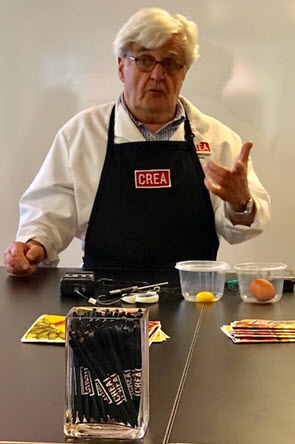
In the classroom with Dr. Bruno Goussault, the creator of sous-vide
There are two divisions under one large corporate umbrella. Cuisine Solutions sells prepared sous-vide foods to Costco, as well as airlines, cruise ships, the military and major hotel chains worldwide. And CREA, with locations in France and Sterling, trains chefs in the sous-vide technique with seminars, on-site training and online video courses. The company opened its $30 million dollar, 163,000 square-foot, state-of-the-art plant in Sterling in 2013.
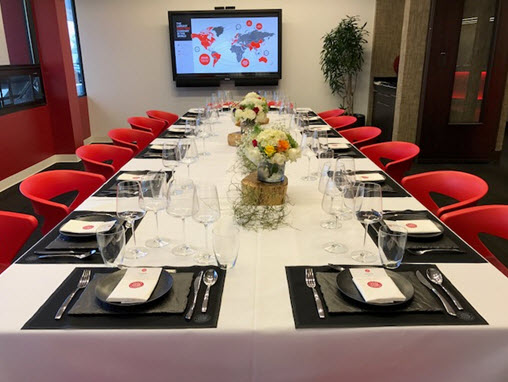
Table set for luncheon in the Executive Dining Room
Along with Goussault’s many years of experience as a scientist and founder of Centre de Recherche et d’Edudes pour Alimentation in Paris as well as recipient of the “Ordre National du Merite” from the President of France, officers in the company have equally extensive pedigrees. Stanislas Vilgrain, Chairman and CEO, rose to the top of his career earning the medal of Chevalier of the Legion of Honor of the French Republic in 2015 after years as a top officer at Vie de France Corporation; Chief Strategy Officer Gerard Bertholon is a Maître Cuisinier de France, one of the world’s highest honors, and trained as a chef under the great Alain Chapel; Felipe Hasselmann, Cuisine Solutions president, brought his powerful international business development experience from L’Oreal Paris, Coca Cola and Frito Lay; and Bruno Bertin, VP of Culinary Innovation who himself has worked with the legendary Pierre Troisgros, Louis Outhier and Daniel Boulud, as Sous Chef at Restaurant Daniel in New York.
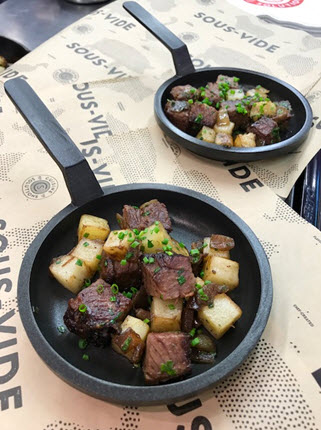
72-Hour Short Rib & Potato Hash
Not only did I watch, learn and participate, but I also spent most of the day tasting the results, beginning with a breakfast prepared by a cadre of chefs schooled in the art of sous-vide. Exquisitely decorated plates were served starting with an egg white and red pepper sous-vide egg bite (these were specially created for Starbucks); bacon and Gruyere egg bite; coconut and chia seed oatmeal parfait; compressed fruit and dragon fruit granite; egg and rosti with sous-vide hollandaise and 72-hour short rib and potato hash served in a miniature cast iron pan.
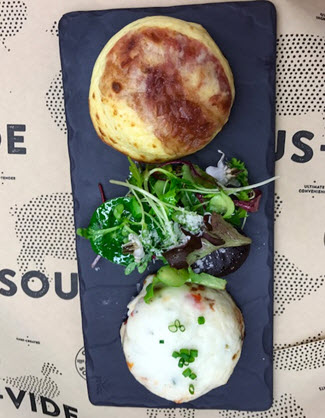
Egg White & Red Pepper Sous-Vide Egg Bite and Bacon & Gruyere Sous-Vide Egg Bite
After breakfast our class moved onto nibbles of “sous-shi” – a trompe l’oeil preparation that looked and even tasted like sushi but was entirely vegetarian; a Moroccan dish of octopus, raisins, capers, compressed melon, pomegranate seeds and radishes; Arctic char brandade with ramp aioli; and a sous-vide pig face which offered up meltingly tender cheek meat. Well fortified, we left the dining area for a large classroom, which is really a laboratory.
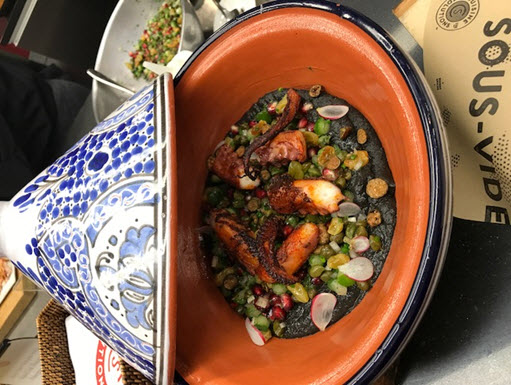
Moroccan-influenced Sous-Vide Octopus
Under the avuncular tutelage of the 75-year old Goussault, “father of sous-vide” and the company’s Founder and Chief Scientist, I slowly shed the neophyte’s notion that sous-vide is a cheater’s technique or a culinary sleight of hand. There is just as much time and effort put into sous-vide preparation as there is with conventional methods. In many cases, a lot more goes into achieving the perfection that it guarantees to the chef. Moreover, I learned that many of the world’s greatest chefs were taught by Goussault – chefs such as Thomas Keller, Heston Blumenthal, Daniel Boulud, Dan Barber, Charlie Trotter, Anne-Sophie Pic and the late Michel Richard, who have embraced it wholeheartedly.
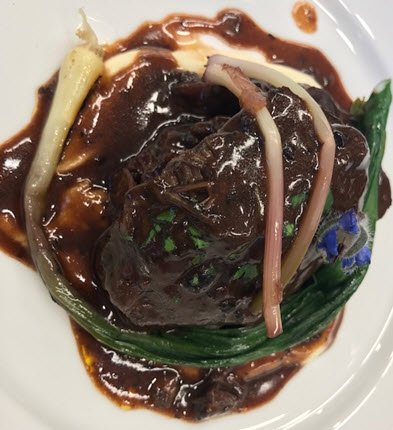
Braised Beef Cheeks over Celery Root Purée with Truffle Triple Sauce & Pickled Ramps garnished with borage flower
During this one-day workshop I became a rabid convert, sometimes tasting conventionally prepared product beside sous-vide prepared foods. I learned how preparing literally tens of thousands of dishes for major events using this method (Cuisine Solutions has catered huge events, like The Ryder Cup and the Super Bowl, for tens of thousands of guests.), offers high quality, consistency, precision and food safety while preventing product loss and spoilage. Meats are cooked uniformly and fruits and vegetables retain the intense signature of the ingredient. This was heady stuff for someone not particularly science-minded.
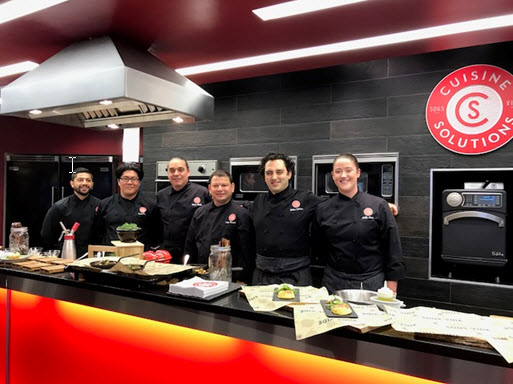
A cadre of chefs create our meals
Dr. Goussault, who invented the two-minute rice while working in food science for the United Nations in Africa, invented sous-vide in the early 1970’s and continued to tweak and promote it with Joël Robuchon in Paris with the establishment of CREA. Armed with probes and monitors Dr. Goussault travels the globe throughout the year training chefs in his methods. He has been compared to Escoffier as a pioneer in the world of gastronomy, and you can take that to the bank! Some of our local chefs who have trained with him at this facility are from Le Diplomate, Mintwood Place, Green Pig Bistro, The Red Hen, Central Michel Richard, Convivial, Fiola and The Dabney, to name but a few.
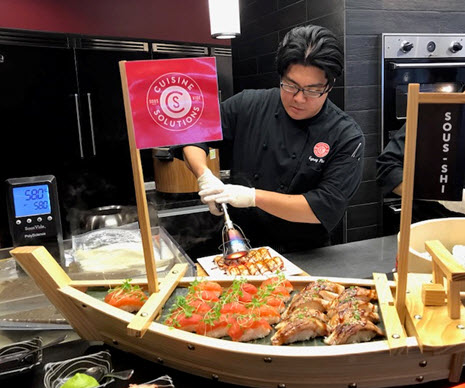
Glazing the vegetarian “Sous-shi”
After discussions on vacuum sealing, water circulators, the precise temperatures for the scale of doneness, and becoming familiar with the various types of machinery involved in this technique, it was time for lunch – Beef sirloin “jar salad’ with ponzu and baby greens; Amazon cod with soy beurre blanc and fiddlehead ferns; braised pork belly over Beluga lentils with shitake broth and wild foraged mushrooms; braised beef cheeks over celery root puree with truffle, triple sauce and pickled ramps. As each dish was sampled it became clearer to me that food prepared sous-vide results in the superior dishes found in the world’s finest restaurants. Each ingredient retains its singular identity, and that is a mind-blowing experience.
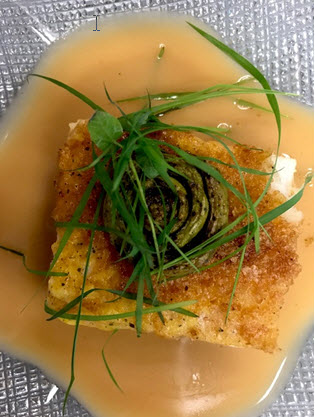
Amazon Cod with Soy Beurre Blanc & Fiddlehead Ferns
Even after such a lavish lunch we continued to sample sous-vide filet of beef, fried chicken, carrots and other delights comparing them alongside traditionally prepared product. The meats were seared and finished on a flat top grill, the chicken crisped up in a fryer. The results were remarkable. In the matter of the chicken, you could just die right there. It was ultra-crispy while still juicy. Carrots tasted as though they were picked fresh from the garden and apples like they had just been plucked off a tree.
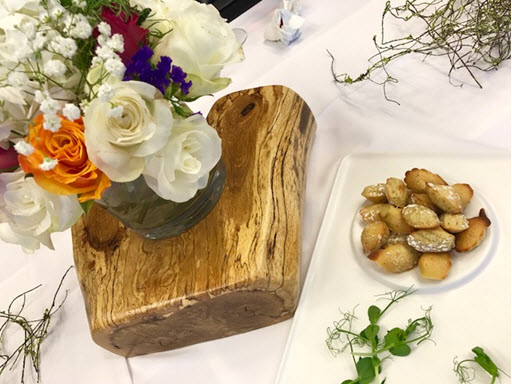
Platter of citrus madeleines
Cramming ten meals into one day wasn’t for the faint of heart, or I should say, stomach. At this point I am wishing I had a cow’s four stomachs and a week to digest everything. But I persist, because this is what I do. And were we done?
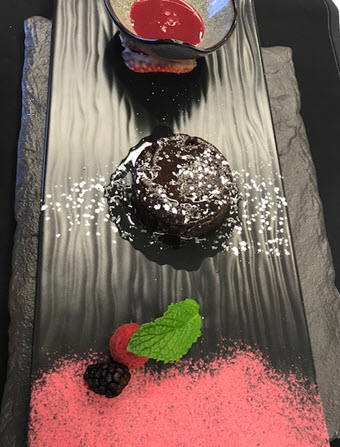
Chocolate Moelleux with Raspberry Coulis
No siree! Desserts were served – chocolate moelleux brightened with raspberry coulis and baskets of citrus madeleines and macarons.
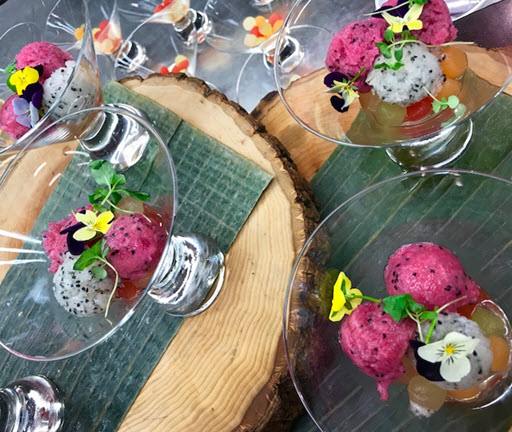
Compressed Fruit & Dragon Fruit Granita
After all this, I’m fairly sure I will never attempt to replicate these dishes at home – equipment costs can be out of sight for home cooks and small restaurants, though many do experiment with the concept of sealing and immersion.
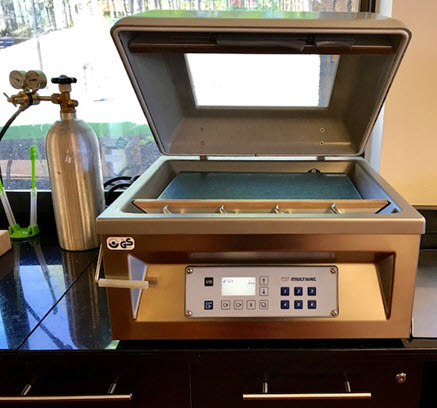
A Multivac seals the food before immersion
I certainly came away with a greater appreciation and keener understanding of what sous-vide means and how lucky I am to have been born when it was invented.
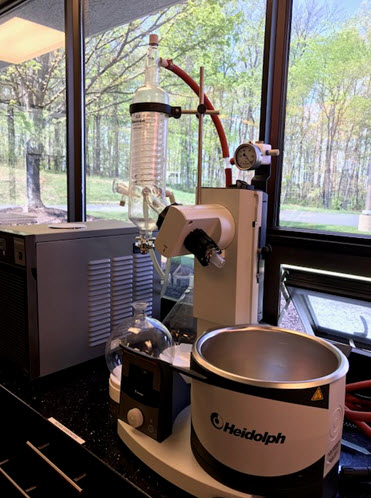
High Tech Rotary Evaporator
Here are some pearls of wisdom from Goussault.
* Water is the best fluid to transfer the heat. When you cook in water you’ll have a beautiful jus.
* Take lemon to the market when you buy fish and squeeze it over the raw fish to determine if it’s fresh. If it turns opaque, it’s NOT fresh.
* The Maillard reaction has to do with the perception of the color of the meat. What do you say in a London fog? All the cats are grey!
* Red meat has a thin layer of albumen. White meat has a thicker layer.
* Vegetables cooked separately retain the integrity of the dish. Cooking vegetables to 85 degrees to respect the pectin will give you the top taste in the world.
* Brine your fish for 10 minutes before cooking. Fifty grams of salt per one quart of water.